

In most cases, this involves either providing participants with a phone preloaded with the app or loading the app onto participants’ own phones and downloading the data at the end of the experimental period. With the advent of smartphones, researchers have increasingly been programming study-specific apps for use in such studies. In such studies, SMS text messages direct participants to follow a link to complete a Web-based survey via their mobile browser or ask them to respond to simple questions about their alcohol consumption via text. Short message service (SMS) text messaging protocols have also been employed. In the case of the former, participants used the device as an electronic diary in the latter, the interactive voice response system was programmed to call participants on researcher-supplied cellular phones so that an automated questionnaire could be administered. Early studies typically featured hand-held electronic devices or interactive voice response systems. Real-time electronic methods of collecting alcohol consumption information for research purposes have evolved rapidly over the last two decades. In this way, the antecedents and consequences of drinking behavior can also be investigated. Crucially, real-time data enable variations in behavior to be examined across time and in concert with cognitive, affective, environmental, and physiological factors.

Real-time methods additionally reduce the quantity of missing data and can yield a diverse and potentially very large sample. As such, recall and response biases are thought to be minimized and the ecological validity of the data is consequently enhanced. This facilitates the collection of actual intake information rather than the summary data commonly elicited from more traditional retrospective methods of assessing drinking.

Such methods-which are increasingly electronic in nature-are advocated on the basis of how they allow data to be captured repeatedly in the natural environment and in the absence of the researcher. Advantages associated with real-time (or near real-time) methods of assessing alcohol consumption behavior for research purposes have been widely documented in recent years.


 0 kommentar(er)
0 kommentar(er)
